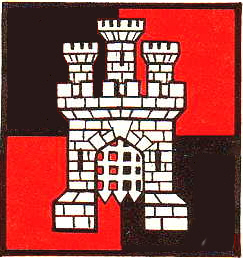Blindfold Simultaneous Chess Exhibition at Worcester
by Ray Collett
In a bindfold display, the master does not see the board or pieces and must remember each position as it arises. The master is not literally blindfolded, but he sits with his back to the board and both the master and challenger call out the moves with the challenger moving the pieces on the chess board.
Blindfold chess is not what Blind chess competitors play: they 'see' the board using the sense of touch. A Blind player has a tactile board, chess set, and clock. The opponent has a separate set and board. A blind player is not allowed to move the pieces except to make a move, but the rule for sighted players - that they must move a piece which has been touched - is not used in Braille chess. A leading English Blind player was Reg Bonham, who taught at Worcester New College and helped found the Interational Braille Chess Association.
Blackburn, unlike many nineteenth century master chess players was not a man of independent means. He was one of the first chess professionals. He made most of his income from giving chess exhibitions.Commonly he would be paid by a club to play blindfold games against several of the leading club players. Blackburn's blindfold simultaneous displays were a marvel of the Victorian leisure scene so it was little wonder that the fashionable set in Worcester invited him to give an exhibition at Worcester.. In 1885, City Chess Club members paid Blackburn to give a a blindfold simultaneous exhibition at Worcester. They arranged for him to play eight games simultaneously without sight of the board. Many eminent doctors were of the opinion that such feats of mental concentration would lead to a breakdown, yet Blackburn travelled the length of the country playing chess because he had no wealthy patron. The score of one of Blackburn's winning games at Worcester was published in Anderson Graham's Mr Blackburn's Games at Chess published by Longmans & Co, 1899 and I have added some annotations.
White: Joseph Henry Blackburn
Black: Rev W. Grundy
Worcester 1885
1.e4 e5 2.Nf3 Nc6 3.d4 exd4 4.Nxd4 Bc5 5.Be3 Qf6 6.c3 Nge7 7.Nc2 Bb6 8.Nba3 Ne5 (The night has taken up a square later required by the queen, for example: 8...0-0 9.Nb5 Qe5) 9.Be2 d6 10.Bxb6 axb6 11.Nb5 Kd8 12.0-0 Qg6 13.f4 N5c6 (White now has an advantage and commands the important king side squares. If 13...Nd7, then 14.Bh5 is annoying.) 14.f5 (Even better was 14.e5!? Nf5 15.exd6 Nxd6 16.Bh5 Qf6 17.Nxd6 cxd6 and white's king is caught in the centre) 14...Qf6 15.Ne3 Re8 (15...Ne5!? was better because after the move in the game black's queen is harried - recurring motif in this variation of the Scotch.) 16.Ng4 Qg5
|
Blackburn-Grundy 1885. Position after 16...Qg5
17.Nxd6! cxd6 18.Qxd6+ Bd7 19.Rad1 Nd5? (A weak move, but 19...Nb8 20.Qxb6+ Kc8 also loses after the white knight moves to e3 and then c4) 20.Rxd5 (20.Qxd5 Re7 21.f6 gxf6 is equally convincing) 20...Qe7 21.Rfd1 Qxd6 22.Rxd6 Rxe4 (Other way of losing are 22...Nb8 23.f6 h5 24.Bb5 hxg4 25.Bxd7 gxf6 26.Bxe8+ Kxe8 27.Rd8 and 22...Re7 23.f6 when white still picks up the piece on d7 pinned aginst the black king.) 23.Rxd7+ Ke8 24.f6 Kf8 25.Bf3 Ree8 26.Bxc6 (26.Rxb7 was better, but blackburn is so far ahead it doesn't matter) 26...bxc6 27.Rb7 b5 28.Rdd7 (And black resigned because he will soon be mated, for example: 28...Re1+ 29.Kf2 Re6 30.Rxf7+ Kg8 31.Rxg7+ Kf8 32.Rxh7 and black has only spite checks before a back rank mate)1-0



















